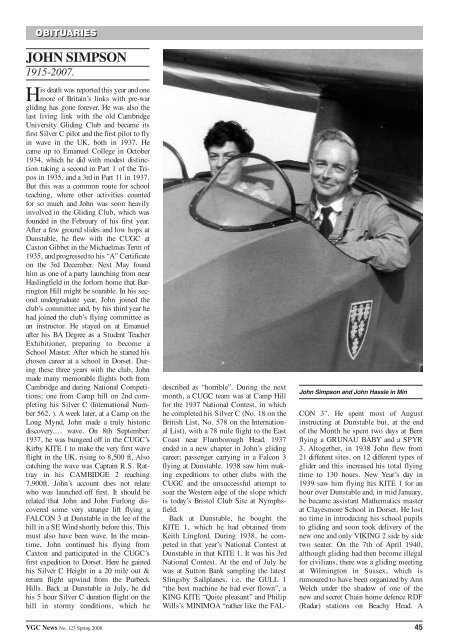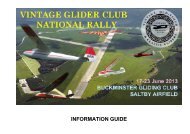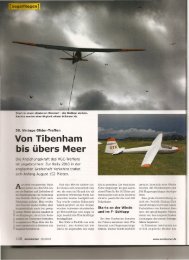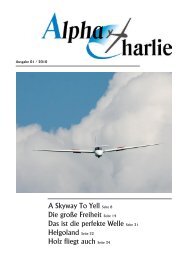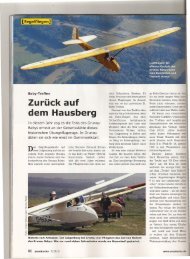Download - Vintage Glider Club
Download - Vintage Glider Club
Download - Vintage Glider Club
You also want an ePaper? Increase the reach of your titles
YUMPU automatically turns print PDFs into web optimized ePapers that Google loves.
OBITUARIES<br />
JOHN SIMPSON<br />
1915-2007.<br />
His death was reported this year and one<br />
more of Britain’s links with pre-war<br />
gliding has gone forever. He was also the<br />
last living link with the old Cambridge<br />
University Gliding <strong>Club</strong> and became its<br />
first Silver C pilot and the first pilot to fly<br />
in wave in the UK, both in 1937. He<br />
came up to Emanuel College in October<br />
1934, which he did with modest distinction<br />
taking a second in Part 1 of the Tripos<br />
in 1935, and a 3rd in Part 11 in 1937.<br />
But this was a common route for school<br />
teaching, where other activities counted<br />
for so much and John was soon heavily<br />
involved in the Gliding <strong>Club</strong>, which was<br />
founded in the February of his first year.<br />
After a few ground slides and low hops at<br />
Dunstable, he flew with the CUGC at<br />
Caxton Gibbet in the Michaelmas Term of<br />
1935, and progressed to his “A” Certificate<br />
on the 3rd December. Next May found<br />
him as one of a party launching from near<br />
Haslingfield in the forlorn home that Barrington<br />
Hill might be soarable. In his second<br />
undergraduate year, John joined the<br />
club’s committee and, by his third year he<br />
had joined the club’s flying committee as<br />
an instructor. He stayed on at Emanuel<br />
after his BA Degree as a Student Teacher<br />
Exhibitioner, preparing to become a<br />
School Master. After which he started his<br />
chosen career at a school in Dorset. During<br />
these three years with the club, John<br />
made many memorable flights both from<br />
Cambridge and during National Competitions;<br />
one from Camp hill on 2nd completing<br />
his Silver C (International Number<br />
562. ). A week later, at a Camp on the<br />
Long Mynd, John made a truly historic<br />
discovery,… wave. On 8th September.<br />
1937, he was bungeed off in the CUGC’s<br />
Kirby KITE 1 to make the very first wave<br />
flight in the UK, rising to 8,500 ft, Also<br />
catching the wave was Captain R.S. Rattray<br />
in his CAMBIDGE 2 reaching<br />
7,900ft. John’s account does not relate<br />
who was launched off first. It should be<br />
related that John and John Furlong discovered<br />
some very strange lift flying a<br />
FALCON 3 at Dunstable in the lee of the<br />
hill in a SE Wind shortly before this. This<br />
must also have been wave. In the meantime,<br />
John continued his flying from<br />
Caxton and participated in the CUGC’s<br />
first expedition to Dorset. Here he gained<br />
his Silver C Height in a 20 mile out &<br />
return flight upwind from the Purbeck<br />
Hills. Back at Dunstable in July, he did<br />
his 5 hour Silver C duration flight on the<br />
hill in stormy conditions, which he<br />
described as “horrible”. During the next<br />
month, a CUGC team was at Camp Hill<br />
for the 1937 National Contest, in which<br />
he completed his Silver C (No. 18 on the<br />
British List, No. 578 on the International<br />
List), with a 78 mile flight to the East<br />
Coast near Flamborough Head. 1937<br />
ended in a new chapter in John’s gliding<br />
career; passenger carrying in a Falcon 3<br />
flying at Dunstable. 1938 saw him making<br />
expeditions to other clubs with the<br />
CUGC and the unsuccessful attempt to<br />
soar the Western edge of the slope which<br />
is today’s Bristol <strong>Club</strong> Site at Nymphsfield.<br />
Back at Dunstable, he bought the<br />
KITE 1, which he had obtained from<br />
Keith Lingford. During 1938, he competed<br />
in that year’s National Contest at<br />
Dunstable in that KITE 1. It was his 3rd<br />
National Contest. At the end of July he<br />
was at Sutton Bank sampling the latest<br />
Slingsby Sailplanes. i.e. the GULL 1<br />
“the best machine he had ever flown”, a<br />
KING KITE “Quite pleasant” and Philip<br />
Wills’s MINIMOA “rather like the FAL-<br />
John Simpson and John Hassle in Min<br />
CON 3”. He spent most of August<br />
instructing at Dunstable but, at the end<br />
of the Month he spent two days at Bern<br />
flying a GRUNAU BABY and a SPYR<br />
3. Altogether, in 1938 John flew from<br />
21 different sites, on 12 different types of<br />
glider and this increased his total flying<br />
time to 130 hours. New Year’s day in<br />
1939 saw him flying his KITE 1 for an<br />
hour over Dunstable and, in mid January,<br />
he became assistant Mathematics master<br />
at Clayesmore School in Dorset. He lost<br />
no time in introducing his school pupils<br />
to gliding and soon took delivery of the<br />
new one and only VIKING 2 side by side<br />
two seater. On the 7th of April 1940,<br />
although gliding had then become illegal<br />
for civilians, there was a gliding meeting<br />
at Wilmington in Sussex, which is<br />
rumoured to have been organized by Ann<br />
Welch under the shadow of one of the<br />
new and secret Chain home defence RDF<br />
(Radar) stations on Beachy Head. A<br />
VGC News No. 123 Spring 2008 45


